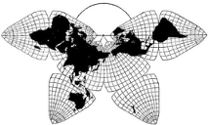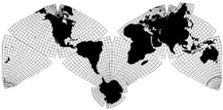#! /usr/bin/perl -w
# Program OOmacroMaker4. This program reads the .csv file output by program
# HalfOctant8, and prepares a file with OOo macros to draw the scaffold half triangle,
# the half octant, minor parallels, minor meridians, major parallels, and major meridians.
#
# The content of the output file will have to be copied into a macro of an OpenOffice.org
# Draw file. It may have to be copied some chunks at a time, because the copy function
# might not be able to handle the many lines.
# The macros require functions L, P, Z and A, which this program does not write.
#
# NOTE: There is only one single file written; each macro is written as a sub, to that file;
# - while preparing each of those subs, they reside in string variables.
#
# - all the coordinates and angles are multiplied by 100 and given as integers, so that they
# are units in 1/100 of a mm or of a degree, of type Long, as OOo Basic wants
# - all the y-values are given as the negative of what they were, to take into account that
# OOo has y positive downwards, whereas my definition is y positive upwards.
#
# NOTE 2: When running the program, there are messages that variables L, dP, and Length
# are used only once. There is no problem; these hashes are read but are not needed for
# the macros.
# Read in all the arrays output by program HalfOctant8.
# Names of arrays are in sub ReadCSV. I am using arrays of arrays for the hashes.
open (CSV, "<Macros8\/Hashes8.csv");
ReadCSV();
close (CSV);
print "Finished reading in the Hashes file.\n";
# Read arrays @dP[][], @L[][], @xJ[][], @yJ[][], @xP[][],@yP[][], @xOctant[], @yOctant[],
# @xTriangle[], @yTriangle[], @LenghtNames[], hash %Lenght{} with keys from array
# @LengthNames[], and values $xC, $yC, the center for arc for parallel 15°
$xA = $xOctant[0]; $yA = $yOctant[0];
# Open output file, to which all the macros will be written
open (OO,">OOMacros8");
$Skip = "";
unless ($Skip) { # Prepare OO macro to draw octant
$Mac = "Sub HalfOctant\nD=ThisComponent\nG=D.DrawPages(0)\n";
$Mac .= "S=L(D,G,RGB(102,0,153))\nN=Array(" . P($xOctant[0],$yOctant[0]);
$n = @xOctant - 1;
foreach $i (1..$n) {
$Mac .= ",_\n" . P($xOctant[$i],$yOctant[$i]);
}
$Mac .= " )\nS.PolyPolygon=Array(N)\nEnd Sub\n\n";
print OO $Mac;
} # End skip of preparing OO macro to draw octant
$Skip = "";
unless ($Skip) { # Prepare OO macro to draw triangle, in light grey
$n = @xTriangle - 1;
$Mac = "Sub Triangle\nD=ThisComponent\nG=D.DrawPages(0)\n";
# Start with last point, and then add all points, so that last point is used twice; this
# creates a closed shape without filling it with color
$Mac .= "S=L(D,G,RGB(200,200,200))\nN=Array(" . P($xTriangle[$n],$yTriangle[$n]);
foreach $i (0..$n) {
$Mac .= ",_\n" . P($xTriangle[$i],$yTriangle[$i]);
}
$Mac .= " )\nS.PolyPolygon=Array(N)\nEnd Sub\n\n";
print OO $Mac;
} # End skip of preparing OO macro to draw triangle
$Skip = "";
unless ($Skip) { # Prepare OO macro to draw meridians
$Major = "Sub MeridiansMajor\nD=ThisComponent\nG=D.DrawPages(0)\n";
$Minor = "Sub MeridiansMinor\nD=ThisComponent\nG=D.DrawPages(0)\n";
$Major .= "C=RGB(0,0,255)\n";
$Minor .= "C=RGB(102,204,204)\n";
foreach $m (0..44) { # For each meridian, except 45°, which is octant boundary
# Will later add line to draw object in correct color to before $Mac;
# $Mac is just temporary for a single meridian.
$Mac = "N=Array(" . P($xJ[$m][0],$yJ[$m][0]);
foreach $j (1..3) { # Polar start, frigid joint, tropic joint, and equator points
$Mac .= ",_\n" . P($xJ[$m][$j],$yJ[$m][$j]);
}
$Mac .= " )\nS.PolyPolygon = Array(N)\n";
if ($m % 5 == 0) { # Major meridians
$Major .= "S=L(D,G,C)\n" . $Mac;
} else { # Minor meridians
$Minor .= "S=L(D,G,C)\n" . $Mac;
}
}
print OO $Major,"End Sub\n\n";
print OO $Minor,"End Sub\n\n";
} # End of skipping the macros for the meridians
$Skip = "";
unless ($Skip) { # Prepare OO macro to draw parallels
$Major = "Sub ParallelsMajor\nD=ThisComponent\nG=D.DrawPages(0)\n";
$Minor = "Sub ParallelsMinor\nD=ThisComponent\nG=D.DrawPages(0)\n";
$Major .= "C=RGB(0,0,255)\n";
$Minor .= "C=RGB(102,204,204)\n";
# Torrid and Temperate zones
# foreach $p (1..14,16..72) { # For each parallel, except 0°, which is octant boundary
# Note: not drawing parallel 15° as partially an arc; if we want an arc, comment the
# following line, uncomment the preceding one, and delete Yes in the next Skip=
# statement.
foreach $p (1..72) { # For each parallel, except 0°, which is octant boundary
# Will later add line to draw object in correct color to before $Mac;
# $Mac is just temporary for a single parallel or parallel object.
$Mac = "N=Array(" . P($xP[0][$p],$yP[0][$p]);
foreach $m (1..45) { # For each node at a meridian
$Mac .= ",_\n" . P($xP[$m][$p],$yP[$m][$p]);
}
$Mac .= ")\nS.PolyPolygon=Array(N)\n";
if ($p % 5 == 0) { # Major
$Major .= "\'P $p\nS=L(D,G,C)\n" . $Mac;
} else { # Minor
$Minor .= "\'P $p\nS=L(D,G,C)\n" . $Mac;
}
}
# Note: if we want to do the arc for parallel 15°, delete the word Yes, here, and on the
# foreach loop above use the foreach that skips parallel 15°.
$Skip = "Yes";
unless ($Skip) { # Parallel 15°.
# Segmented line portion
$Mac = "N=Array(" . P($xP[0][15],$yP[0][15]);
foreach $m (1..30) { # For each node at a meridian
$Mac .= ",_\n" . P($xP[$m][15],$yP[$m][15]);
}
$Mac .= " )\nS.PolyPolygon=Array(N)\n";
$Major .= "\'P 15\nS=L(D,G,C)\n" . $Mac;
# Circular arc section of Parallel 15°
use Math::Trig;
$R = sqrt(($xP[45][15] - $xC)**2 + ($yP[45][15] - $yC)**2);
$Start = rad2deg(atan2($yP[30][15] - $yC, $xP[30][15] - $xC) );
$End = rad2deg(atan2($yP[45][15] - $yC, $xP[45][15] - $xC) );
$Mac = sprintf ("%.0f,%.0f,%.0f,%.0f,%.0f",
$xC*100,-$yC*100,$R*100,$Start*100,$End*100);
$Major .= "G.add(A(D,$Mac,C))\n";
} # End skip of circular arc section of Parallel 15°
# Frigid supple zone
# Straight line of parallel 73° -- single straight line, but using PolyLine, anyway
$Mac = "\'P 73\nS=L(D,G,C)\n";
$Mac .= "N=Array(" . P($xP[30][73],$yP[30][73]) . "," . P($xP[45][73],$yP[45][73]);
$Mac .= ")\nS.PolyPolygon=Array(N)\n";
$Minor .= $Mac;
# Segmented-line section of parallel 74°
$Mac = "\'P 74\nS=L(D,G,C)\n N=Array(" . P($xP[30][74],$yP[30][74]);
foreach $m (31..45) { # For each node at a meridian
$Mac .= ",_\n" . P($xP[$m][74],$yP[$m][74]);
}
$Mac .= ")\nS.PolyPolygon=Array(N)\n";
$Minor .= $Mac;
# Arcs of parallels 73° and 74°
for $p (73..74) {
$R = $xP[0][$p] - $xA;
$Mac = sprintf ("%.0f,%.0f,%.0f",$xA*100,-$yA*100,$R*100);
$Minor .= "\'P $p\nG.add(A(D,$Mac,0,3000,C))\n";
}
# Frigid zone
for $p (75..89) {
$R = $xP[0][$p] - $xA;
$Mac = sprintf ("%.0f,%.0f,%.0f",$xA*100,-$yA*100,$R*100);
if ($p % 5 == 0) { # Major
$Major .= "\'P $p\nG.add(A(D,$Mac,0,4500,C))\n";
} else { # Minor
$Minor .= "\'P $p\nG.add(A(D,$Mac,0,4500,C))\n";
}
}
print OO $Major,"End Sub\n\n";
print OO $Minor,"End Sub\n\n";
} # End of skipping of doing parallels
close(OO);
# - - - - - - - - - - - - - - - - - - - - - - - - - - - - - - - - - - - - - - - - - - - - - -
sub P {
# Takes in two values, multiplies them by 100, rounds them to an integer,
# multiplies the second one by -1, and returns string: P(number,number)
# E.g. input 23.546,23.546 would return "P(2355,-2355)"
return sprintf("P(%.0f,%.0f)", $_[0]*100, -$_[1]*100);
} # end of sub P
sub ReadCSV {
# It is assumed that the file is already opened, with filehandle CSV
while (<CSV>) {
$Line = $_; chomp ($Line);
if ($Line eq "") {
next; # blank line
} elsif (index($Line, "dP") >= 0) {
@dP = ReadArray();
} elsif (index($Line,"L") >= 0) {
@L = ReadArray();
} elsif (index($Line,"xJ") >=0) {
@xJ = ReadArray();
} elsif (index($Line,"yJ") >=0) {
@yJ = ReadArray();
} elsif (index($Line,"xP") >=0) {
@xP = ReadArray();
} elsif (index($Line,"yP") >=0) {
@yP = ReadArray();
} elsif (index($Line,"Points") >=0) {
# Format is slightly different for this line/array/hash
$Line = <CSV>; chomp ($Line);
($i, @xOctant[0,1,2,3,4,5], @xTriangle[1,2],$xC) = split(/\t/,$Line);
$Line = <CSV>; chomp ($Line);
($i, @yOctant[0,1,2,3,4,5], @yTriangle[1,2],$yC) = split(/\t/,$Line);
$xTriangle [0] = $xOctant [5]; # Point G
$yTriangle [0] = $yOctant [5]; # Point G
} elsif (index($Line,"Lengths") >=0) {
# Format is slightly different for this array
($i, @LengthNames) = split(/\t/,$Line);
$Line = <CSV>; chomp ($Line);
($i, @temp) = split(/\t/,$Line);
$n = @temp - 1;
foreach $i (0..$n) { $Length{$LengthNames[$i]} = $temp[$i]; }
} else {
print "Don\'t know what to do with this line:\n";
print $Line, "\n";
} # End of if-statement
} # End of reading data
} # End of sub ReadCSV
sub ReadArray {
my ($Line, $i, $j, @temp, @Array);
while (<CSV>) {
$Line = $_; chomp ($Line);
if ($Line eq "") {last;} # blank line means end of this array
($i, @temp) = split(/\t/,$Line);
$n = @temp - 1;
if ($i eq "") {next;} # Ignore header line
foreach $j (0 .. $n) { $Array [$j][$i] = $temp[$j];} # save values
}
return @Array;
} #End of sub ReadArray
|



